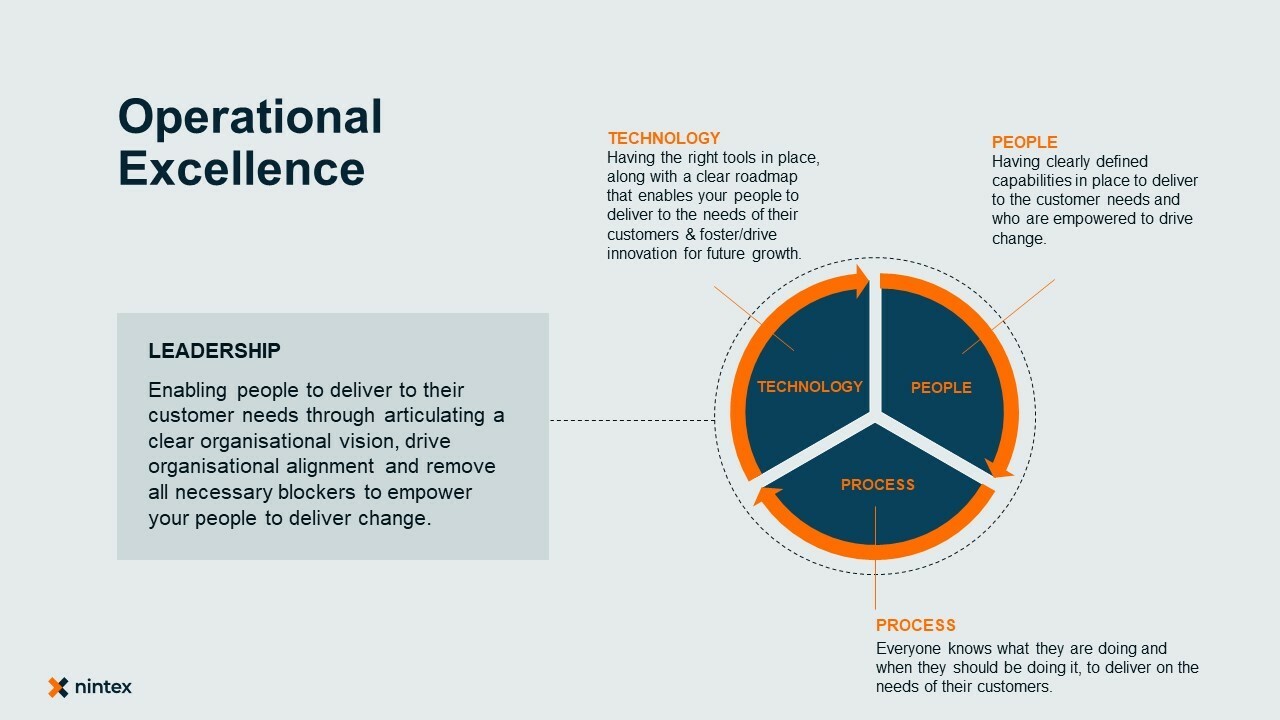If you were to ask your staff to produce a list of your organization’s assets, what do you think they would include? Perhaps your product designs, your plant, equipment, inventory, and people. How many people would add your processes to that list? For most organizations, the answer will be very few (if any). The reason for this is because most people focus on the products and services that they offer their customers, without considering how these products and services are created and marketed in the first place.
This is where Operational Excellences (OPEX) comes in. We define OPEX as building your organization with a focus on putting the right people, process, and technology in place such that your competitive advantage doesn’t just come from what you do, but also how you do it. Of course, this must all be driven and supported by your leadership team.

Let's break these components down one by one.
People
You need to ensure that your people have the capabilities and resources needed to execute the processes that you design, because there’s no point creating amazing processes if your staff are unable to perform them. Additionally, your staff need to be empowered to identify where their processes are not fit for purpose and then drive change through continuous improvement.
Process
You need to have clearly defined processes in place so that, at any given time, everyone in your team understands what they need to do and how they do it. Your process should be designed in such a way that, if they are performed exactly as they have been documented, you’ll consistently produce the outputs needed to deliver on your internal and external customer’s expectations.
Technology
This involves ensuring that your people have the tools that they need to perform their processes in the simplest and most effective way possible. This encompasses both the tech stack that you have for your staff to perform their processes, as well as the automation tools that will allow you to reassign work from human participants to a system.
It's important to remember that process drives technology, not the other way around, meaning that you must start by optimizing your process and then find the most appropriate technology, rather than designing your processes around the limitations of your existing tech stack.
As your processes change, either by design or through the introduction of technology, you will then have to upskill your people to ensure that they have the capabilities to perform the new process.
Leadership
OPEX is ultimately a culture where everyone in your organization believes that the way that they work, not just the work that they do, will help determine if the organization achieves its objectives or not. Of course, to build this culture you need engagement from your leadership team (at all levels) to provide support, remove obstacles, and provide the resources required for the business to execute. Additionally, leadership must create a culture of change where your team not only expect the way that they work to be constantly changing, but are actively looking to drive change through bottom-up continuous improvement.
This all might seem straight-forward enough, so the question then becomes why do so many organizations struggle to execute on their OPEX initiatives?
The first answer is that they fail to consider and address all four elements of OPEX, rather focusing in isolation on what they believe to be the most critical component. For example, if your business has experienced rapid growth, adding headcount without considering processes (i.e. focusing only on the people component) will set you up to have an army of new starters with no idea of what they are supposed to do, or pinch-points caused by processes that are unable to scale. Alternatively, if you attempt to fix your problems by simply automating anything that moves (i.e. focusing only on the technology component), you are likely to end up performing your broken processes much faster and many more times and, in doing so, cause more problems than you solve.
Another common (and related) cause is that your Line of Business (LoB) may lack the skills and/ or time needed to execute. For example, without a background in process automation, someone within your LoB may be unable to identify how automation technology could help them solve a process problem (let alone build the solution). Equally, even if they have the technical ability to map and improve their own processes, most people are busy enough with their day job and simply don’t have the time to dedicate to these OPEX initiatives.
By now it might be becoming evident that while OPEX can be an enormously powerful tool, effectively executing an OPEX initiative is easier said than done. There are several approaches that you can take to overcome these challenges; for example, you might choose to train up an army of citizen developers and increase your headcount such that everyone has time in their day to dedicate to OPEX, or perhaps you might outsource these activities to an external consultant. Another solution is to establish a Center of Excellence (CoE). While establishing a CoE will not make sense for all organizations, under the right circumstances a CoE can assist an organization to achieve its OPEX objectives where it might have otherwise struggled.
Stay tuned for next week’s post in our five part CoE blog series, where we’ll explore what exactly a CoE is, as well as the different approaches that a CoE can take.

